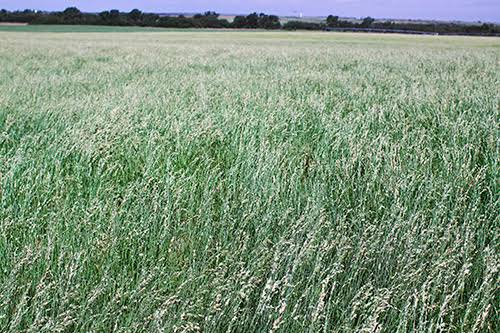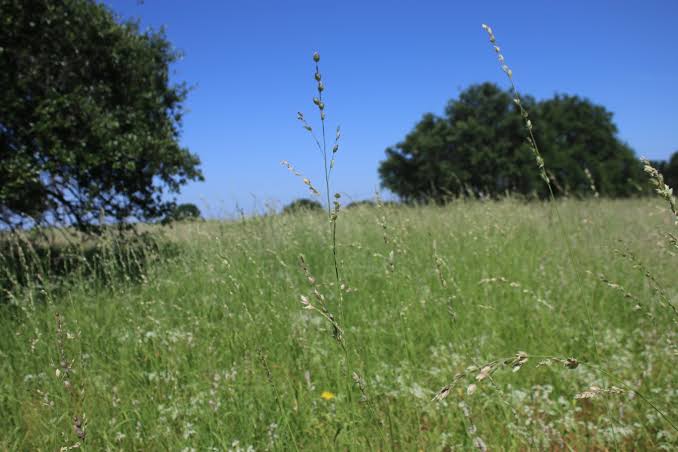Wilman lovegrass (Eragrostis superba) is a beautiful and unique grass species that captures the attention with its graceful appearance. This plant, native to South Africa, is known for its slender stems and feathery flower heads that sway gently in the breeze.
In its natural habitat, Wilman lovegrass often thrives in open grasslands and meadows, displaying a vibrant green color that adds a touch of elegance to the landscape. Its scientific name, Eragrostis superba, reflects its superb and remarkable qualities.
The slender stems of Wilman lovegrass can reach impressive heights, creating a delicate and airy effect. Its inflorescence, or flower head, consists of numerous tiny flowers that form a distinctive feathery panicle. This panicle is a key feature that distinguishes Wilman lovegrass from other grass species.
One of the notable characteristics of Wilman lovegrass is its adaptability to different soil types. It can be found in a variety of environments, ranging from sandy soils to rocky areas. This versatility makes it a resilient and hardy plant, capable of thriving in diverse conditions.
Beyond its aesthetic appeal, Wilman lovegrass plays a crucial role in supporting local ecosystems. The grass provides habitat and food for various insects, birds, and small mammals. Its extensive root system also helps prevent soil erosion, contributing to the overall stability of the environment.
Cultivating Wilman lovegrass in gardens and landscapes is a popular choice for those seeking to enhance the visual appeal of outdoor spaces. Gardeners appreciate its low maintenance requirements and the graceful movement it brings to the garden, especially when planted in groups or as a border plant.
In addition to its ornamental value, Wilman lovegrass has been utilized in traditional medicine by some indigenous communities. Extracts from the plant have been used for their potential medicinal properties, although scientific research on this aspect is still ongoing.
While Wilman lovegrass has found favor in various regions as an ornamental plant, it’s essential to manage its growth carefully. In some areas outside its native habitat, it has been considered invasive, spreading rapidly and outcompeting native vegetation. This highlights the importance of responsible cultivation and monitoring to prevent any adverse ecological impacts.
In addition, Wilman lovegrass (Eragrostis superba) is a captivating grass species that adds charm to its surroundings. With its slender stems, feathery flower heads, and adaptability, this grass has earned its place in both natural landscapes and cultivated gardens. As we appreciate its aesthetic qualities, it is crucial to approach its cultivation responsibly to ensure harmony with the environment.
Read Also: Appearance, Features and Benefits of Clams
How To Grow Wilman Lovegrass (Eragrostis superba)

To cultivate Wilman lovegrass (Eragrostis superba) successfully, follow these general guidelines:
1. Select an Appropriate Location: Choose a sunny spot with well-draining soil for optimal growth. Wilman lovegrass prefers open areas that receive ample sunlight throughout the day.
2. Prepare the Soil: Ensure the soil is well-draining and amend it with organic matter if necessary. This grass species is adaptable to various soil types, but good drainage is essential to prevent waterlogging.
3. Sow Seeds: Plant Wilman lovegrass seeds directly into the prepared soil. Gently press the seeds into the soil surface, as they require light for germination. Avoid burying them too deeply.
4. Watering: Keep the soil consistently moist during the germination period. Once established, Wilman lovegrass is relatively drought-tolerant, but regular watering promotes healthier growth.
5. Maintenance: Prune or trim the grass occasionally to maintain its shape and prevent it from becoming overly dense. This encourages air circulation and helps prevent potential diseases.
6. Fertilization: Wilman lovegrass is not excessively demanding when it comes to fertilization. A balanced, slow-release fertilizer applied in spring can provide the necessary nutrients for robust growth.
7. Monitor for Invasive Spread: Keep an eye on its growth to prevent it from becoming invasive in certain regions. Regularly check for any unwanted spreading and take appropriate measures if needed.
8. Enjoy the Aesthetic Appeal: Once established, Wilman lovegrass will showcase its graceful appearance, with slender stems and feathery flower heads swaying in the breeze. Appreciate the natural beauty it adds to your garden or landscape.
9. Responsible Cultivation: If cultivating Wilman lovegrass outside its native habitat, be mindful of its potential invasiveness. Avoid introducing it into sensitive ecosystems and adhere to local guidelines for responsible plant cultivation.
By following these simple guidelines, you can cultivate Wilman lovegrass and enjoy its unique beauty while ensuring its harmonious coexistence with the surrounding environment.
How To Care For Wilman Lovegrass (Eragrostis superba)
Caring for Wilman lovegrass (Eragrostis superba) involves attention to its specific needs:
1. Watering: Provide regular watering, especially during dry periods. While Wilman lovegrass is somewhat drought-tolerant once established, consistent moisture helps maintain its vibrant appearance.
2. Pruning: Periodically trim or prune the grass to promote air circulation and prevent it from becoming overly dense. This enhances the overall health of the plant and encourages new growth.
3. Soil Maintenance: Ensure the soil remains well-draining. If you notice waterlogging or poor drainage, amend the soil with organic matter to improve its structure.
4. Fertilization: Wilman lovegrass doesn’t require excessive fertilization. A balanced, slow-release fertilizer applied in the growing season can provide the necessary nutrients for healthy development.
5. Monitoring for Pests and Diseases: Regularly inspect the grass for signs of pests or diseases. Address any issues promptly to prevent them from affecting the overall well-being of the plant.
6. Harvesting Seeds: If you wish to propagate Wilman lovegrass, allow some flower heads to mature and harvest the seeds. This can be done by gently shaking the seeds into a container.
7. Responsible Disposal: If you need to remove any parts of the plant, dispose of them responsibly. Avoid spreading seeds in unintended areas to prevent potential invasiveness.
8. Adapting to Local Conditions: Consider local climate conditions and adjust care practices accordingly. Wilman lovegrass is adaptable but may benefit from specific adjustments based on your region’s climate.
9. Appreciating Natural Beauty: Take time to appreciate the aesthetic beauty of Wilman lovegrass. Its graceful form and feathery flower heads contribute to the visual appeal of your garden or landscape.
By incorporating these care practices, you can nurture Wilman lovegrass and maintain its health and beauty in your outdoor space.
Read Also: Appearance, Features and Benefits of Crabs
The Uses of Wilman Lovegrass (Eragrostis superba)

Wilman lovegrass (Eragrostis superba) has various uses, both ornamental and practical:
1. Ornamental Landscaping: One of the primary uses of Wilman lovegrass is in ornamental landscaping. Its slender stems and feathery flower heads make it a popular choice for gardens and outdoor spaces, adding a touch of elegance and movement.
2. Soil Erosion Control: The extensive root system of Wilman lovegrass aids in preventing soil erosion. This makes it valuable for stabilizing soil on slopes or areas prone to erosion.
3. Wildlife Habitat: Wilman lovegrass provides habitat and food for various insects, birds, and small mammals. Its presence in an ecosystem contributes to biodiversity and supports local wildlife.
4. Traditional Medicine: In some indigenous communities, extracts from Wilman lovegrass have been used in traditional medicine. Research is ongoing to explore its potential medicinal properties.
5. Dried Flower Arrangements: The feathery flower heads of Wilman lovegrass can be dried and used in floral arrangements. This adds a unique and airy element to bouquets and decorative displays.
6. Adaptability to Different Soils: Its adaptability to different soil types makes Wilman lovegrass a versatile choice for landscaping projects. It can thrive in various environments, from sandy soils to rocky areas.
7. Cultural Significance: In its native South Africa, Wilman lovegrass may hold cultural significance for certain communities. Its beauty and adaptability may be appreciated in local traditions and practices.
8. Low-Maintenance Gardens: For gardeners seeking low-maintenance plants, Wilman lovegrass is an attractive option. Once established, it generally requires minimal care and can thrive in less-fussy garden settings.
9. Awareness of Invasiveness: While it has positive uses, it’s important to be aware of Wilman lovegrass’s potential invasiveness in certain regions. Responsible cultivation and monitoring are crucial to prevent unintended ecological impacts.
Overall, the uses of Wilman lovegrass span from aesthetic enhancements in gardens to practical applications in erosion control, showcasing its versatility and ecological contributions.
Frequently Asked Questions (FAQs)
Q: What is Wilman lovegrass (Eragrostis superba)?
A: Wilman lovegrass is a grass species native to South Africa, known for its slender stems and feathery flower heads. It is often cultivated for ornamental purposes.
Q: How do I grow Wilman lovegrass in my garden?
A: Choose a sunny location with well-draining soil. Plant seeds directly in the soil, press them lightly, and keep the soil consistently moist during germination. Once established, provide regular care and maintenance.
Q: Is Wilman lovegrass invasive?
A: In some regions outside its native habitat, Wilman lovegrass can become invasive. It’s crucial to monitor its growth and prevent unintended spreading in sensitive ecosystems.
Q: Can Wilman lovegrass tolerate drought?
A: Yes, once established, Wilman lovegrass is relatively drought-tolerant. However, regular watering during dry periods can promote healthier growth.
Q: Are there any pests or diseases that affect Wilman lovegrass?
A: Like any plant, Wilman lovegrass may be susceptible to pests or diseases. Regularly inspect the grass and address any issues promptly to maintain its overall health.
Q: Can I use Wilman lovegrass in dried flower arrangements?
A: Yes, the feathery flower heads of Wilman lovegrass can be dried and used in floral arrangements, adding a unique and airy element to bouquets.
Q: What is the cultural significance of Wilman lovegrass?
A: In its native South Africa, Wilman lovegrass may hold cultural significance for certain communities, appreciating its beauty and adaptability in local traditions.
Q: How can I prevent Wilman lovegrass from becoming invasive in my area?
A: Be mindful of its growth, avoid spreading seeds in unintended areas, and adhere to local guidelines for responsible plant cultivation to prevent unintended ecological impacts.
Q: Can Wilman lovegrass be used for soil erosion control?
A: Yes, the extensive root system of Wilman lovegrass makes it valuable for stabilizing soil on slopes or areas prone to erosion. It contributes to soil conservation efforts.
Q: Is Wilman lovegrass suitable for low-maintenance gardens?
A: Yes, Wilman lovegrass is a suitable choice for low-maintenance gardens. Once established, it generally requires minimal care and can thrive in less-fussy garden settings.
Read Also: Guide to Recycling of Wastes and Advantages of Recycling
